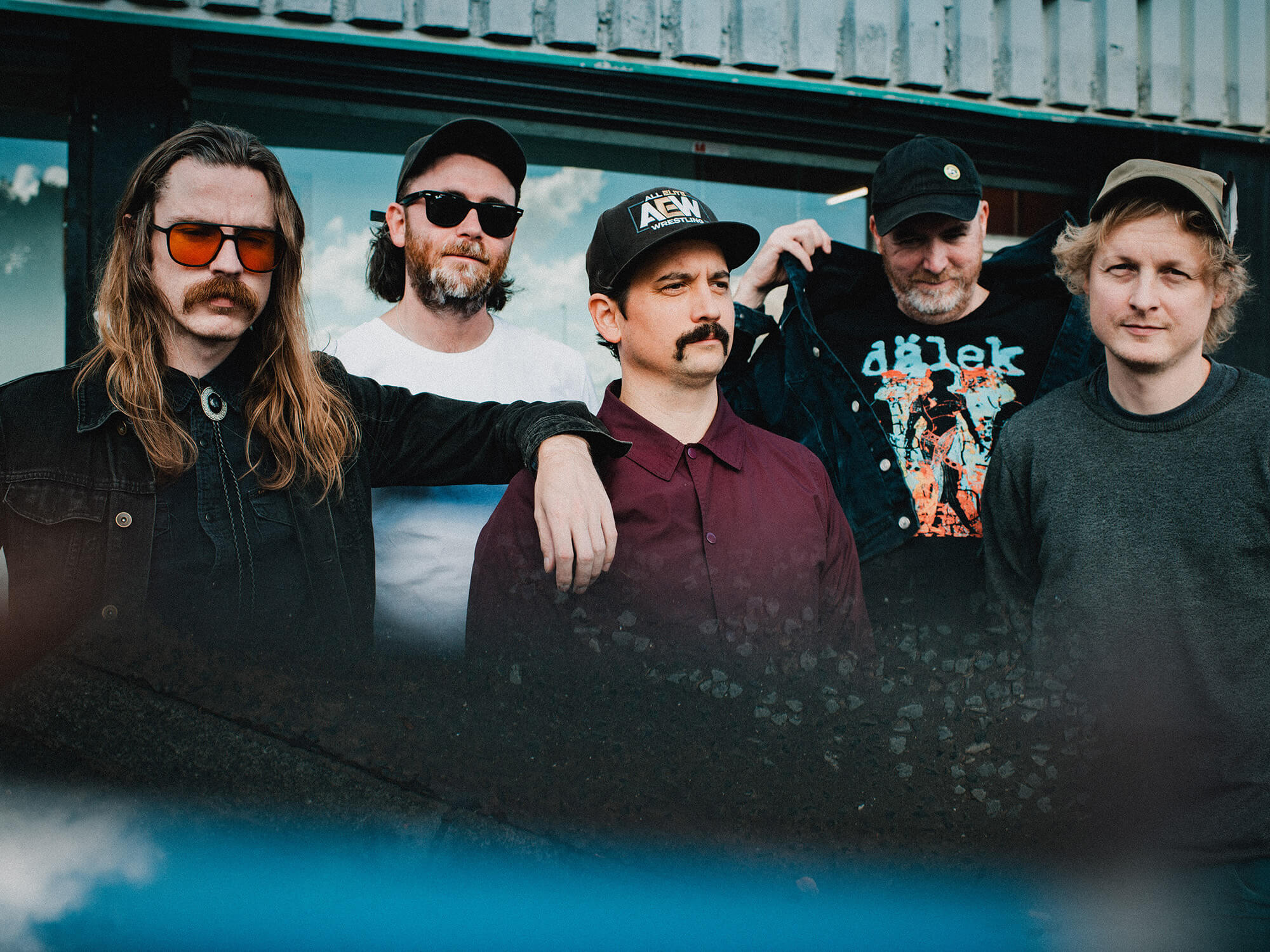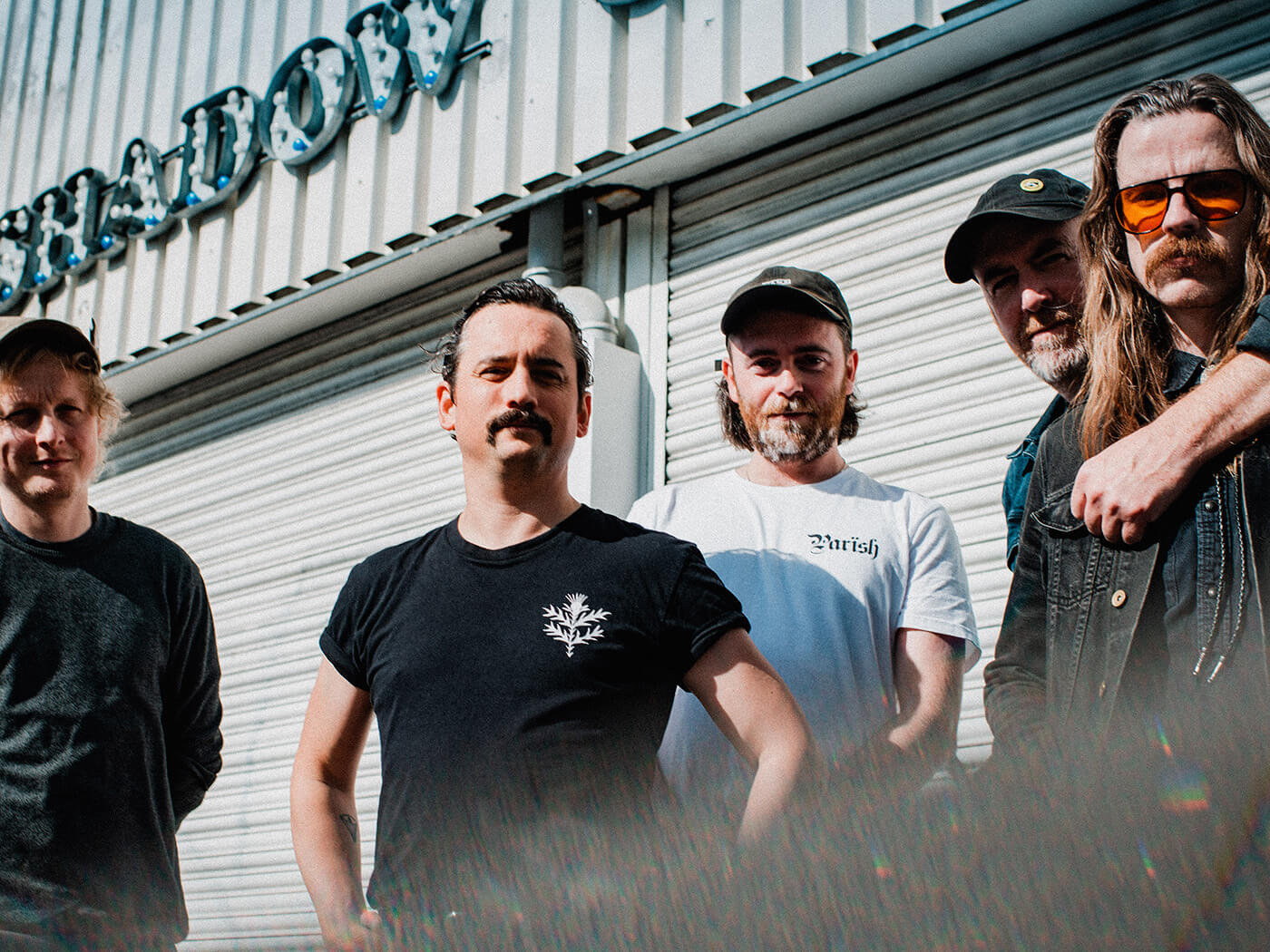“I would just turn every dial to full and it sounds amazing” Pigs Pigs Pigs Pigs Pigs Pigs Pigs on the primordial riff roots of Land Of Sleeper
The Newcastle riff kings on the return of their original drummer, embracing doom, and the power of a well-mic’d valve amp helped them channel riff gold on their latest LP.

Image: Ania Shrimpton
There’s a certain amount of self-belief involved in calling a song Ultimate Hammer. A song called Ultimate Hammer must rock and it must rock hard—there are no degrees of ultimate, there is only ultimate. Pigs Pigs Pigs Pigs Pigs Pigs Pigs’ Ultimate Hammer rocks and it rocks hard – it sounds like Black Sabbath eating ZZ Top beard-first, riding a syrupy groove that would be eminently danceable if it wasn’t trying to crush you.
As openers go, it’s a perfect stall-setter for everything the Newcastle-based riff lords try to achieve on their new LP Land of Sleeper, an eight-song behemoth that pushes their sound further into doomy recesses, spaced-out drone and eye-bulging fury from vocalist Matt Baty. Everything that guitarists Adam Ian Sykes and Sam Grant do during its 41 minutes sounds huge, reflecting past preoccupations while upping the ante.
It is Evil Dead 2 to Viscerals’ original schlock-fest—packed with moments of gonzo violence but also off-the-wall humour and washes of genuine psychedelic weirdness.
A key ingredient in its construction that sets it apart from its 2020 predecessor is the return of drummer Ewan Mackenzie, a sonic extremist who’s back in the saddle for the first time in six years.
“His heart lies with heavy music, really heavy music,” Sykes says. “It kind of gave us a bit of a push to revisit some of our old stuff, whether that was subconscious or not, while playing with him and learning songs again, or teaching him the new songs and his changes to those. We knew we wanted this to be a bit heavier, certainly from the production side, but I think Ewan’s influence is a huge part of that.”
Primordial sludge
Connoisseurs of this sort of primordial sludge will note a couple of things about the way Sykes and Grant have taken this flash of inspiration and used their ultimate hammer to fashion something harsh and sometimes ugly while keeping alive a genuine sense of warmth. The riffs here aren’t spiky or scything, they’re rich and full-bodied, utilising fuzz tones that feel like drowning in a shag pile carpet.
“Sound at source is key,” Grant says. “Both Adam and I are using old-style valve amps, my Orange CR120, a Vox AC30. The very foundational elements before we even put mics up were rich harmonically. I really like to work loads with ribbon mics, which impart loads of that warmth, and then I’ll use a condenser or dynamic mic to bring in some bite and some harshness or some air.”
“It is testament to how sound at source can really shift the production, it does all the hard work when it comes to the vibe down the line,” he adds. “We did a lot of reamping too. I’d take a DI of the guitar so I had the performance. On the rhythm guitars I would reamp the double track through the AC30. Oftentimes I wouldn’t use pedals, I would just turn every dial to full, and it sounds amazing.”
Sykes, meanwhile, likes to switch out his main dirt pedal on each album, chasing something slightly different without moving too far from a tone that delivers a gloopy, molasses-style thickness. Here, he used an TS-808 clone alongside a B.G Harding S:P for the nasal, biting riffage of Mr. Medicine, a short, sharp exercise in banging heads. “I’ve been through so many fuzz pedals and always come back to the ones that have nice round low mids,” he says. “It’s that weight.”

Parallel lines
That weight is absolutely vital to the Pigs x7 sound. Alongside Mackenzie, bassist John-Michael Hedley has a field day on Land of Sleeper, grinding through pummelling lines in lockstep with the rhythm guitars. It is relentless. “There’s a thing I’ve been playing around with, which is parallel basses,” Grant says. “It’s tracking the bass twice and having it hard panned left and right.
“If you manage it right and mix it right, it clears the centre space for the drums. Both my guitars are double tracked and panned left and right, and the bass is double tracked left and right. You get these two columns of sound, and because they’re not ever going to be quite with each other, it creates this width right up the range with a master. Adam was working a lot with Matt about the voice in the centre of the image, the thing that has freedom and movement.
“It’s something we’ve done in the production on previous records, but never to the extent it is on this one. I was also really obsessed with putting piano all over the album, especially the bottom octave mirroring the riffs. It meant that there was loads of space to add elements like that, or little moments of synth. It’s probably the biggest depth sonically of any album we’ve done.”

The guitar situation itself, though, is a little more pared back. Grant used to depend on a Fender Toronado but, with the model no longer being manufactured, he became paranoid about putting his short-scale go-to on flights. He eventually drafted in a Telecaster Deluxe fitted with Shawbuckers.
“I’m really settled with it. I really like Fender necks, and I don’t like Gibson necks at all,” he says. “But it’s got a sound that’s very similar to a Les Paul with those pickups. It’s just a bit more airy. There’s just a hair more detail in it than a Les Paul, but still with a good thickness with the humbuckers. I almost exclusively use that.”
Sykes lives on the other side of the Fender/Gibson divide a lot of the time, but is less of a zealot. “For the most part I use my ’61 reissue SG, which I bought over lockdown,” he says. “I used to have a Special, which I ended up breaking at a gig. I really miss it. The SG is kind of the perfect neck for me, which is the thing I’m most interested in. We used that when we double- or triple-tracked the rhythm stuff and I used an American Special Jazzmaster for most of the lead stuff. It’s also a fairly new acquisition. I really love it. I could never get away with Jazzmasters. I don’t know what it is about that model but it really, really hits that spot for me when it comes to lead stuff, the P-90s are real nice.”

Riff ratio
Baty’s gut-wrenching vocals pose another question for the band’s guitarists. As well as providing the fuzz, the duo carry much of the melodic responsibility. Interestingly, this is another consideration that falls under their team ethic – each song represents a five-way appreciation for how to best fill an allotted area. Sykes observes that Pigs x7’s music is “90 per cent riff”, with relatively few licks or hooky leads, so it’s about assembling progressions that carry a melodic movement in their makeup, eventually binding that to the swing behind Mackenzie’s contributions. “With Ewan it feels like writing with another guitarist. He is so melodic in his playing,” Sykes says.
“We definitely live and die by the rhythmic element of the music,” Grant adds. “The riffs we’re playing are very simple. The music is always the sum of its parts—there’s not really a need for any sort of virtuosity, nor is there the talent for any sort of virtuosity. The drums can fill the gaps or the riffs will fill the gaps between the drums. It becomes really holistic.
“The key is always that we’re writing something that makes you want to nod your head, and then trying to find the nuance within the rhythm so it can suddenly switch. Terror’s Pillow does that—there’s a bit where we played it live a few times and the crowd starts nodding, and then suddenly on the seven, it goes back to the start. We feel a bit guilty about that because we’re kind of taking away that magic moment. But once you get your head around it, it becomes this really satisfying thing.”

Drone strike
During The Weatherman, a near-seven-minute cut that sits at the heart of Land of Sleeper like a gravity-obliterating black hole, Pigs x7 put this theory to the test. It isn’t the longest or most punishing drone exercise out there but the song – featuring Bonnacons of Doom vocalist Kate Smith and, among its choir, the prolific experimental duo Richard Dawson and Sally Pilikington – is patient, immersive and dynamic.
It strings out familiar elements in the band’s sound and trusts the listener to follow their lead, moving from folk-horror ambience to skull-cracking distortion on a dime. The key to unlocking its squalling heft was found when Grant and Sykes, sitting in a studio control room, resolved to slow Baty’s original demo down. “There was this epiphany,” Grant says.
“We all have a history of playing that style of music,” he adds. “One of the bands we were in – me and Adam at separate times – used to write 40-minute tracks where you just cycle the loop, cycle and cycle it. It would start to evolve just by its repetition. All of a sudden, as soon as you change it, it’s euphoric.”
People love Pigs x7 because they chase this feeling in each aspect of their music. They go at their creative decisions by bending every sinew, as though they have resolved to win or, if that doesn’t happen, fail with everything they have. When it comes to writing riffs, this attitude is everything. “It’s just this idea of cranking it and cranking it and seeing how long you can take something before it just has to rattle off its hinges,” Grant says.
Pigs Pigs Pigs Pigs Pigs Pigs Pigs’ Land of Sleeper is out 17 February on Rocket Recordings.
